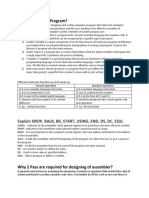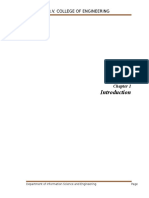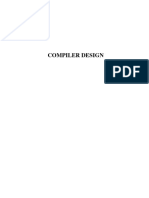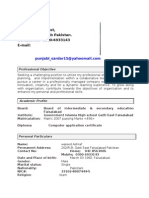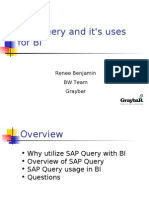4.6 Fundamentals of Computer Systems
4.6 Fundamentals of Computer Systems
Uploaded by
louistestevensCopyright:
Available Formats
4.6 Fundamentals of Computer Systems
4.6 Fundamentals of Computer Systems
Uploaded by
louistestevensCopyright
Available Formats
Share this document
Did you find this document useful?
Is this content inappropriate?
Copyright:
Available Formats
4.6 Fundamentals of Computer Systems
4.6 Fundamentals of Computer Systems
Uploaded by
louistestevensCopyright:
Available Formats
🖥
4.6 Fundamentals of computer
systems
Status
4.6.1 Hardware and software
4.6.1.1 Relationship between hardware and software
Understand the relationship between hardware and software and be able to
define the terms:
hardware
software
4.6.1.2 Classification of software
Explain what is meant by:
system software
application software
Understand the need for, and attributes of, different types of software.
4.6 Fundamentals of computer systems 1
4.6.1.3 System software
Understand the need for, and functions of the following system software:
operating systems (OSs)
utility programs
libraries
translators (compiler, assembler, interpreter).
4.6.1.4 Role of an operating system (OS)
Understand the need for, and functions of the following system software:
operating systems (OSs)
utility programs
libraries
translators (compiler, assembler, interpreter).
4.6.2 Classification of programming
languages
Show awareness of the development of types of programming languages and
their classification into low-and high-level languages.
Know that low-level languages are considered to be:
machine-code
assembly language
Know that high-level languages include imperative high-level language.
Describe machine-code language and assembly language.
Understand the advantages and disadvantages of machine-code and assembly
language programming compared with high-level language programming.
Explain the term ‘imperative high-level language’ and its relationship to low-level
languages.
4.6.3 Types of program translator
4.6 Fundamentals of computer systems 2
Understand the role of each of the following:
assembler
compiler
interpreter
Explain the differences between compilation and interpretation. Describe
situations in which each would be appropriate.
Explain why an intermediate language such as bytecode is produced as the final
output by some compilers and how it is subsequently used.
Understand the difference between source code and object (executable) code.
4.6.4 Logic gates
Construct truth tables for the following logic gates:
NOT
AND
OR
XOR
NAND
NOR
❗ Students should know and be able to use ANSI/IEEE standard 91-
1984 Distinctive shape logic gate symbols for these logic gates.
Be familiar with drawing and interpreting logic gate circuit diagrams involving one
or more of the above gates.
Complete a truth table for a given logic gate circuit.
Write a Boolean expression for a given logic gate circuit.
Draw an equivalent logic gate circuit for a given Boolean expression.
Recognise and trace the logic of the circuits of a half-adder and a full-adder.
Construct the circuit for a half-adder.
4.6 Fundamentals of computer systems 3
Be familiar with the use of the edge-triggered D-type flip-flop as a memory unit.
Knowledge of internal operation of this flip-flop is not required.
4.6.5 Boolean algebra
Be familiar with the use of Boolean identities and De Morgan’s laws to
manipulate and simplify Boolean expressions.
4.6 Fundamentals of computer systems 4
You might also like
- F-22A Raptor: Flight ManualDocument49 pagesF-22A Raptor: Flight ManualOusmaneNo ratings yet
- 6502 Assembly Language Subroutines PDFDocument562 pages6502 Assembly Language Subroutines PDFPanthros100% (2)
- SPCC Viva Question PDFDocument36 pagesSPCC Viva Question PDFKanchan100% (4)
- What Are System Program?: Explain Drop, Balr, BR, Start, Using, End, DS, DC, EquDocument3 pagesWhat Are System Program?: Explain Drop, Balr, BR, Start, Using, End, DS, DC, EquSomil BichpuriyaNo ratings yet
- MIPS Assembly Language Programmer's GuideDocument244 pagesMIPS Assembly Language Programmer's Guidekusasi@No ratings yet
- Syllabus:: Computer Programming and Data StructuresDocument34 pagesSyllabus:: Computer Programming and Data StructuresGanesh SinghNo ratings yet
- Question Bank Ii - Cse - Programming Language: 10. Explain in Detail Multiple Selection Constructs?Document3 pagesQuestion Bank Ii - Cse - Programming Language: 10. Explain in Detail Multiple Selection Constructs?it's ARKNo ratings yet
- 82001Document85 pages82001Mohammed ThawfeeqNo ratings yet
- 6502 Assembly Lanuage Rountines Part 1 TextDocument284 pages6502 Assembly Lanuage Rountines Part 1 Textlinux cernelNo ratings yet
- APCSA1 Fundamentals Java CH 01 WSSummer 2022Document6 pagesAPCSA1 Fundamentals Java CH 01 WSSummer 2022Yousef HasanNo ratings yet
- CS1352PCD2MARKSDocument30 pagesCS1352PCD2MARKSsridharanc23No ratings yet
- Compiler DesignDocument12 pagesCompiler Designanonymousofficial717No ratings yet
- B.tech Semester III System Software 08-08-2023 (Revised)Document5 pagesB.tech Semester III System Software 08-08-2023 (Revised)yadavdivy3No ratings yet
- R.V. College of EngineeringDocument34 pagesR.V. College of EngineeringPunith RaajNo ratings yet
- PCC All Units QuestionBankDocument121 pagesPCC All Units QuestionBankimakhil.1684No ratings yet
- Compilation Systems Volume 1 (Tools) : 0890459-050 April 1999Document388 pagesCompilation Systems Volume 1 (Tools) : 0890459-050 April 1999BastönNo ratings yet
- SP Solutions - AdiDocument63 pagesSP Solutions - AdiProtibha sinhaNo ratings yet
- System Software Solve PaperDocument13 pagesSystem Software Solve PaperArthiNo ratings yet
- Unit 1Document32 pagesUnit 1pathakaashish993No ratings yet
- PCD Important QuestionDocument28 pagesPCD Important QuestionGaurav SahuNo ratings yet
- 4.7 Fundamentals of Computer Organisation and ArchitectureDocument6 pages4.7 Fundamentals of Computer Organisation and ArchitecturelouistestevensNo ratings yet
- Research PaperDocument8 pagesResearch Paperapi-644965001No ratings yet
- Compiler DesignDocument94 pagesCompiler DesignPradeepkumar PradeepkumarNo ratings yet
- CD Unit1 NotesDocument28 pagesCD Unit1 NotesSharmili Nukapeyi NNo ratings yet
- Course+Assessment+Rubrics+Microprocessor+Interfacing+ +programmingDocument3 pagesCourse+Assessment+Rubrics+Microprocessor+Interfacing+ +programmingHassan AliNo ratings yet
- End Sem CDDocument97 pagesEnd Sem CDcaptainshaheenbaghNo ratings yet
- System Software NotesDocument81 pagesSystem Software Notesuma sNo ratings yet
- Compiler Construction Principles and PracticeDocument15 pagesCompiler Construction Principles and PracticeTarun BeheraNo ratings yet
- CD Unit - 1 Lms NotesDocument58 pagesCD Unit - 1 Lms Notesashok koppoluNo ratings yet
- Files 1 2019 May NotesHubDocument 1559140311Document220 pagesFiles 1 2019 May NotesHubDocument 1559140311GapitoNo ratings yet
- 4.1 Fundamentals of ProgrammingDocument7 pages4.1 Fundamentals of ProgramminglouistestevensNo ratings yet
- Revision Checklist F453Document9 pagesRevision Checklist F453Amrita PanesarNo ratings yet
- Lecture 08 Language Translation PDFDocument11 pagesLecture 08 Language Translation PDFJONATHAN WABWIRENo ratings yet
- Compiler Design-NotesDocument212 pagesCompiler Design-NotescsehodNo ratings yet
- Compiler Construction Using Flex and Bison - Aaby - Anthony ADocument102 pagesCompiler Construction Using Flex and Bison - Aaby - Anthony Anyedamd100% (1)
- UNIT 5 - Programming LanguagesDocument11 pagesUNIT 5 - Programming LanguagesGeorge ChiricaNo ratings yet
- Project Work 1Document7 pagesProject Work 1abhishek.09tkeNo ratings yet
- DocumentationDocument36 pagesDocumentationAnkit JainNo ratings yet
- PowerPC Assembly OverviewDocument9 pagesPowerPC Assembly Overviewbisti tuNo ratings yet
- C SyllabusDocument1 pageC SyllabusJatin SharmaNo ratings yet
- Assignment 2Document8 pagesAssignment 2Sarp MNo ratings yet
- Compiler Design QuantumDocument251 pagesCompiler Design QuantumJatin SahniNo ratings yet
- Assembly LanguageDocument27 pagesAssembly LanguageRogin BeldadNo ratings yet
- Compiler Design Ch1Document13 pagesCompiler Design Ch1Vuggam VenkateshNo ratings yet
- KCG College of Technology, Chennai-96 Computer Science and EngineeringDocument14 pagesKCG College of Technology, Chennai-96 Computer Science and EngineeringSwarnendu GhoshNo ratings yet
- Assignment SCDlabDocument5 pagesAssignment SCDlabNoor-Ul AinNo ratings yet
- Chapter1 Analysis of The Source ProgramDocument22 pagesChapter1 Analysis of The Source ProgramjorexamorNo ratings yet
- Introduction To Compilers Complier: Ompiler Source Program Target Program Error MessageDocument23 pagesIntroduction To Compilers Complier: Ompiler Source Program Target Program Error MessagehardcoremendelNo ratings yet
- 1 - Core Java (TOC)Document229 pages1 - Core Java (TOC)jagadeeshNo ratings yet
- Module 1Document91 pagesModule 1Saksham Singh100% (1)
- Create New LanguageDocument26 pagesCreate New LanguagepuneetNo ratings yet
- 2021 CE143 Practical ListDocument24 pages2021 CE143 Practical ListItachi UchihaNo ratings yet
- Notes Compile CompleteDocument117 pagesNotes Compile Completenewb53223No ratings yet
- Phase TransitionDocument21 pagesPhase TransitionSoloproNo ratings yet
- Assignment No.: 01: Name: Shraddha Umesh Mulay Roll No.: 221083 GR No.: 22020260 Sy-ADocument8 pagesAssignment No.: 01: Name: Shraddha Umesh Mulay Roll No.: 221083 GR No.: 22020260 Sy-Ashraddha mulayNo ratings yet
- Compiler Notes - UllmanDocument182 pagesCompiler Notes - UllmanD Princess ShailashreeNo ratings yet
- Imp SADocument4 pagesImp SASharad PratapNo ratings yet
- Build Your Own Programming Language: A programmer's guide to designing compilers, interpreters, and DSLs for solving modern computing problemsFrom EverandBuild Your Own Programming Language: A programmer's guide to designing compilers, interpreters, and DSLs for solving modern computing problemsNo ratings yet
- Linux Kernel Debugging: Leverage proven tools and advanced techniques to effectively debug Linux kernels and kernel modulesFrom EverandLinux Kernel Debugging: Leverage proven tools and advanced techniques to effectively debug Linux kernels and kernel modulesNo ratings yet
- Key Performance Indicator Project ManagementDocument4 pagesKey Performance Indicator Project ManagementMohsyn Syed67% (6)
- Waleed CVDocument2 pagesWaleed CVJohn AleemNo ratings yet
- Smart Air Quality Monitoring SystemDocument7 pagesSmart Air Quality Monitoring SystemIJRASETPublicationsNo ratings yet
- Dept. of CSE, VVIT Dept. of CSE, VVITDocument7 pagesDept. of CSE, VVIT Dept. of CSE, VVITHemanth GoliNo ratings yet
- Simple, Beautiful Notes For Ableton Live: Getting Started GuideDocument10 pagesSimple, Beautiful Notes For Ableton Live: Getting Started GuideClément GillauxNo ratings yet
- SafeCer Deliverable 2 1 1 Rev 1 1Document42 pagesSafeCer Deliverable 2 1 1 Rev 1 1Alexandru DahnoviciNo ratings yet
- What Is Digital Forensics by Rodney McKemmishDocument6 pagesWhat Is Digital Forensics by Rodney McKemmishChristos PeristerisNo ratings yet
- Make A 3D Printer Course 7 Instructor Guide: Fusion 360: Foundational ConceptsDocument3 pagesMake A 3D Printer Course 7 Instructor Guide: Fusion 360: Foundational ConceptsReadoneNo ratings yet
- COA Question Bank For MamDocument9 pagesCOA Question Bank For Mamsubhash221103No ratings yet
- 1SBC125003C0204-Automation+Products BRDocument88 pages1SBC125003C0204-Automation+Products BREverton Soares PivottoNo ratings yet
- LohgDocument19 pagesLohgOlifNo ratings yet
- WP2017 O-2-2-4 GDPR MobileDocument70 pagesWP2017 O-2-2-4 GDPR MobileVasunNo ratings yet
- 7013-4 - Basic Nav FunctionsDocument37 pages7013-4 - Basic Nav Functionsirakli100% (1)
- D7sys Funktion BDocument530 pagesD7sys Funktion BpandhuNo ratings yet
- Saint Laurent Bags For Women MytheresaDocument1 pageSaint Laurent Bags For Women MytheresaMélissa BenziadaNo ratings yet
- Key Shortcuts WinampDocument3 pagesKey Shortcuts WinamppandakikiNo ratings yet
- Toon Boom Animation Inc. White Paper: 2D-3D Integration PipelineDocument9 pagesToon Boom Animation Inc. White Paper: 2D-3D Integration Pipelineemmanz masonNo ratings yet
- Document Control Procedure ExampleDocument4 pagesDocument Control Procedure ExampleShraddha Mishra50% (6)
- DVR Fast Operation ManualDocument6 pagesDVR Fast Operation ManualRichard CentenoNo ratings yet
- HyperV Implementation On PowerVault MD Series Storage ArraysDocument33 pagesHyperV Implementation On PowerVault MD Series Storage ArraysDavi MazuiNo ratings yet
- SERVOPAC Angle Calibrator ManualDocument4 pagesSERVOPAC Angle Calibrator ManualDeyen OcuNo ratings yet
- Sap Ad-Hoc QueryDocument54 pagesSap Ad-Hoc Queryapi-3852248100% (7)
- Introduction To Automata Theory: Reading: Chapter 1Document15 pagesIntroduction To Automata Theory: Reading: Chapter 1naveen saiNo ratings yet
- Virtual Magnifying Glass 3.4: IndexDocument7 pagesVirtual Magnifying Glass 3.4: IndexDavid SimNo ratings yet
- Requisitos de Sistema PRTGDocument8 pagesRequisitos de Sistema PRTGjhonel pari castroNo ratings yet
- Temperature Controlled Fan SpeedDocument4 pagesTemperature Controlled Fan Speedsgrao2010549No ratings yet
- # Decrypt My Files #Document5 pages# Decrypt My Files #Dean Rizky Pratama0% (1)
- Project Timeline With MilestonesDocument3 pagesProject Timeline With MilestonesShady Mohamed El-KhattabyNo ratings yet
- CV. Anderson Hario Pangestiaji (English Version)Document5 pagesCV. Anderson Hario Pangestiaji (English Version)Anderson PangestiajiNo ratings yet



